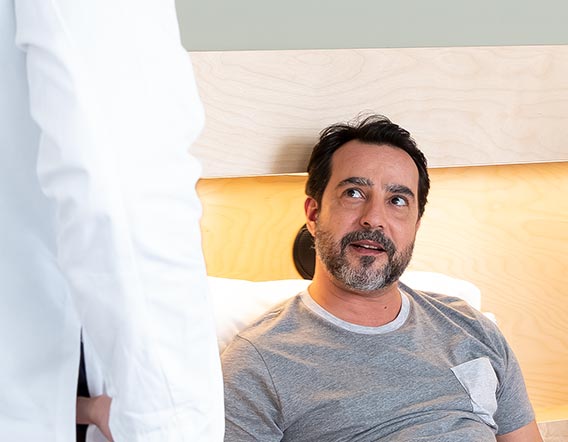Parasomnias
Sleep disordersParasomnias
Parasomnias are characterised by complex abnormal sleep-related movements, behaviour, emotions, perceptions, dreams and activation of the autonomic nervous system.
Sleep deprivation, psycho-traumatic treatments, alcohol, stress and intense physical activity in the evening are some of the factors associated with parasomnia.
Parasomnia disorders can be broken down into 3 categories :
- Non-REM parasomnia
- REM parasomnia
- Other parasomnia disorders
Parasomnia disorders can also be the result of an underlying sleep pathology.
The different types of parasomnias
Non-REM parasomnia
REM parasomnia
- REM sleep behaviour disorders (RBD). These episodes occur during REM sleep, most often in the second half of the night. The subject enacts their dream, which can lead to violent behaviour. RBD especially affects men over the age of 50. Medication is recommended for this sleep disorder, as it can result in injury for the subject or their spouse. It is also important to look for sleep apnoea syndrome, as it can exacerbate RBD episodes.
- Nightmares are unpleasant and terrifying dreams with a feeling of oppression and anxiety that often trigger the subject to wake up abruptly, with a detailed memory of the dream’s content. They occur almost exclusively during REM sleep (second half of the night), especially in people with mood or anxiety disorders and narcolepsy. When such episodes occur repeatedly (for more than three months and more than once a week) and impact sleep quality, it is essential to see a specialist and receive treatment. This is called nightmare disorder, and psychotherapy can be useful to desensitise the patient to their nightmares. If the results aren’t satisfactory, medication may be considered, even if non-specific.
- Recurrent isolated sleep paralysis is characterised by – often minor – episodes of generalised motor paralysis when falling asleep or waking. These episodes are usually brief (a few seconds) but may cause anxiety.
Other parasomnia disorders
- Nocturnal enuresis refers to episodes of involuntary urination (bedwetting) after the age of 5 years that occur at least twice a week for a period of more than 3 months.
- Hypnagogic hallucinations occur during sleep (hypnagogic) or upon awakening (hypnopompic), and are most predominant in women. These are mainly visual hallucinations that last a few seconds, and are often associated with sleep paralysis.
- Exploding head syndrome (EHS) is characterised by the perception of a violent noise (explosion, gun, electric shock or slamming door) in the subject’s head when falling asleep or sleeping. It may be associated with visual flashes or sensations of heat.
- Sleep eating disorders are characterised by the urge to eat and drink in a partially awake state. In addition to the consumption of high-calory products, subjects might ingest inedible products. There is often no (or very partial) memory of the occurrence.
Is parasomnia treatable ?
While some parasomnia disorders are transient or typical of childhood with no serious consequences, others may require specific treatment.
In all cases, the aim should be to eliminate precipitating factors by adjusting living habits. Approaches such as hypnosis or relaxation are alternatives to medication, and can prove effective in some cases.
For some severe forms of parasomnia, pharmacological treatment may be considered.


 Share on facebook
Share on facebook
 Share on twitter
Share on twitter
 Share on linkedin
Share on linkedin
 Share by email
Share by email